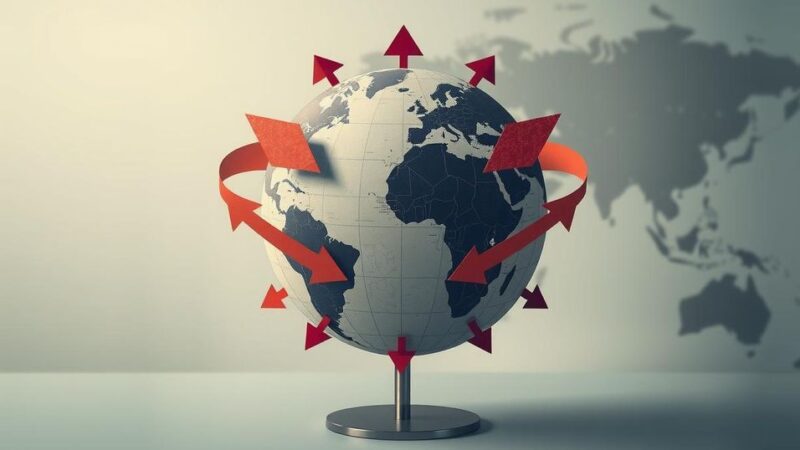China has responded to U.S. tariffs by imposing a 15% duty on selected American exports, marking a renewed trade conflict. Targeted items include coal and liquefied natural gas, alongside an investigation into Google. The tariffs may lead to higher consumer prices and affect economic growth, mirroring past tariff disputes. President Trump’s administration frames these tariffs as critical to protecting U.S. interests.
The trade conflict between the United States and China has escalated again, following China’s announcement of a 15% tariff on select American exports in response to U.S. tariffs. This marks a revival of the trade war, which had previously shown signs of resolution after President Donald Trump abandoned his plans for 25% tariffs on Mexico and Canada, while still imposing a 10% tariff on China. In retaliation, China targeted imports such as coal, liquefied natural gas, and vehicles, and initiated an investigation into Google for alleged monopolistic practices.
China’s tariffs are more selective compared to those threatened by Mexico and Canada, which would have impacted a broader range of consumer goods. It remains uncertain whether these measures are intended to disrupt crucial U.S. industries or serve as a tool for negotiation. President Trump has persistently criticized China, holding it accountable for facilitating the distribution of fentanyl in the U.S. and for undercutting American electronics firms.
The ongoing tension includes potential tariffs on the European Union, with Trump emphasizing trade imbalances. He stated, “They don’t take our cars, they don’t take our farm products, they take almost nothing and we take everything from them.” The EU has warned of retaliation if tariffs are enforced. Trump also suggested a tailored trade agreement with the United Kingdom, which is no longer part of the EU, may be on the horizon.
Historical patterns indicate that Trump’s approach mirrors his actions in 2018 when he imposed tariffs on washing machines and solar panels, setting off a cycle of back-and-forth negotiations with China. The subsequent trade agreement in 2020, which aimed at increasing U.S. exports to China, has been complicated by the economic repercussions of the pandemic. The persistence of tariffs under Biden’s administration suggests the possibility of enduring economic conflict.
While tariffs on Canada and Mexico have been postponed, there are concerns that Trump’s tariff strategies may negatively impact the global economy. Economists caution that tariffs typically contribute to inflation and could inhibit growth, potentially leading to stagflation, where inflation rises amid economic stagnation. The Dow Jones Industrial Average dropped over 600 points in a chaotic market response to the tariff news.
Eric Winograd of Alliance Bernstein warned that tariffs resemble taxes that could reduce economic growth by decreasing consumer spending power. The real question is whether increased business costs due to tariffs will be transferred to consumers as price hikes. Past evidence suggests that tariffs significantly raised consumer prices in previous conflicts, which may recur under the current circumstances.
Moreover, shifting supply chains to cope with tariffs could threaten profit margins, further inflating consumer costs. Tariffs imposed by other nations on U.S. goods create additional challenges for American exporters. Alongside economic considerations, Trump and his administration frame concessions from neighboring countries as evidence of successful trade policy aimed at curbing illegal fentanyl trafficking. White House Press Secretary Karoline Leavitt emphasized, “The president is committed to ensuring that Canada and Mexico and China understand that the United States is not going to be a dumping ground for illegal fentanyl that are killing young people in this country.”
The ongoing trade conflict between the United States and China represents a significant chapter in international economic relations, largely focused on tariffs and trade policies. The trade war has heightened tensions, influencing broader markets and bilateral agreements. Previous tariffs have shaped relations, leading to negotiations designed to foster mutual economic growth and address key trade imbalances. The dynamics surrounding tariffs on China, the EU, and U.S. neighbors reveal deeper implications for consumer prices and global trade structures, making it a crucial area of interest for economists and policymakers alike.
In summary, the renewed trade war between the U.S. and China has significant ramifications for global economics, reflecting ongoing tensions over tariffs that could inflate consumer prices and hamper growth. With targeted tariffs from China responding to U.S. measures, the economic landscape appears precarious, potentially resulting in prolonged disputes. Historical patterns suggest that these trade conflicts might influence international relations and domestic markets alike, reinforcing the need for strategic negotiation and policy foresight.
Original Source: www.usnews.com






